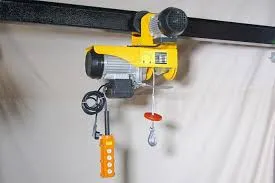In the world of heavy lifting, a 4-ton manual chain hoist stands as a paragon of reliability and strength. These hoists are indispensable for numerous industries, from construction to shipping, due to their simplicity, durability, and cost-effectiveness. Unlike their electric counterparts, manual chain hoists do not require electricity, making them ideal for locations with limited or no power supply.

The design and operation of a 4-ton manual chain hoist are rooted in centuries-old mechanical principles, yet they incorporate modern materials and engineering to ensure efficiency and safety. The primary components include the load chain, the lifting mechanism, and the hand chain. The load chain, usually made from high-grade steel, is the backbone of the hoist, providing the necessary tensile strength to lift substantial weights. The lifting mechanism comprises gears and a braking system, enabling smooth and controlled lifting operations. The hand chain is the driving force, operated manually by pulling, which turns the gears and lifts the load.
A distinguishing advantage of the 4-ton manual chain hoist is its ease of maintenance. With fewer moving parts compared to powered hoists, maintenance typically involves regular lubrication and inspections for wear or damage. This simplicity not only reduces downtime but also enhances longevity, making these hoists a cost-effective choice for businesses.

Furthermore, manual chain hoists are renowned for their portability and versatility. Weighing significantly less than electric hoists, they can be easily transported and installed in various settings, from remote construction sites to indoor facilities with minimal clearance. This flexibility makes manual chain hoists an excellent option for businesses looking to maximize their operational efficiency without a significant investment in infrastructure.
The operation of a 4-ton manual chain hoist, while straightforward, still necessitates proper training and adherence to safety protocols to prevent accidents and ensure optimal performance. Operators should be well-versed in load limit norms, procedures for even load distribution, and emergency measures. Training focuses on the proper manual handling techniques, understanding load capacities, and identifying potential hazards.
In terms of expertise, manufacturers of 4-ton manual chain hoists invest significantly in research and development to enhance the performance and safety features of their products. For instance, advanced braking systems, such as Weston-style load brakes, are often incorporated to prevent the load from slipping and ensure precise load control. The expertise embedded in these hoists reflects decades of innovation and experience, ensuring they remain a trusted tool in demanding lifting applications.
4 ton manual chain hoist
From an authoritativeness perspective, credible manufacturers provide detailed specifications, safety certifications, and user manuals to reinforce trust in their products. Certification from recognized bodies, such as ISO or ANSI, attests to the quality and safety standards upheld in the manufacturing process. This transparency is vital for informed purchasing decisions and guarantees that the hoist will perform as expected under rigorous conditions.
Trustworthiness is further enhanced through customer reviews and endorsements from industry professionals. Positive feedback concerning reliability, performance, and after-sales support amplifies a product's credibility. Moreover, companies offering robust customer service, including technical support and warranty repairs, greatly enhance the trust customers have in their products.
When selecting a 4-ton manual chain hoist, considerations such as the hoist's build quality, ease of use, and available safety features should be at the forefront. Leading hoist manufacturers often offer a range of models tailored to specific needs, whether it be heightened durability for harsh environments or increased lift heights for particular applications.
The industry for manual chain hoists continues to evolve, with ongoing advancements in material science and engineering technology. These innovations promise enhancements in weight-to-strength ratios, corrosion resistance, and ergonomic design, further solidifying the manual chain hoist’s status as an essential tool in industrial lifting operations.
In summary, the 4-ton manual chain hoist remains a staple in heavy lifting, combining proven mechanical principles with modern engineering to deliver unmatched reliability and performance. Prioritizing safety, simplicity, and cost-efficiency, these hoists are an enduring testament to engineering excellence and a vital asset across various industries worldwide.








